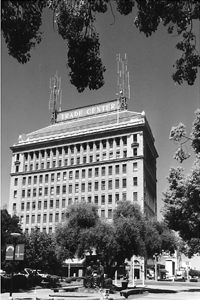   |
||||||||
| Today, 2005 Fulton Mall is the outstanding example of a 20th century urban landscape, "With its almost unique assemblage of Beaux Arts classical office buildings, the impressive 1925 downtown skyline of Fresno could probably not have been duplicated beyond California... A city's historic architecture.
Eckbo changed the nature of landscape architecture through his practice and writings. His first publication, in 1950, of "Landscape for Living," artfully blends what Eckbo identified as environmental designs, "five basic types of material: earth, rock, water, vegetation and construction." He called for a new approach to landscape architecture that integrated society, ecology and design. This was a departure from the past patterns. He wanted to create patterns "in which people live and play, not stand and look." . When Eckbo explained his design for the Fulton Mall, he reflected the importance of agriculture in the San Joaquin Valley; "The plentitude of quiet and moving waters, and of shade and greenery from trees and arbors, symbolizes the bursting vitality of irrigated agriculture in the hot interior valley of the arid west" ("Fresno Mall Revisited," Landscape Architecture.) |
||||||||
|
|
||||||||
 is like a living museum, with
out an appreciation or at least a sense of its past, a
culture risks evisceration." (early Tall Buildings, by
Dickenson Weber, Landscape Press, 1988)
is like a living museum, with
out an appreciation or at least a sense of its past, a
culture risks evisceration." (early Tall Buildings, by
Dickenson Weber, Landscape Press, 1988)